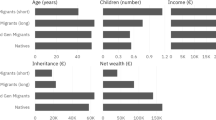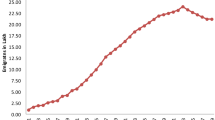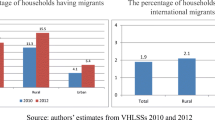Abstract
This paper examines the causes and effects of migration in Uganda. It is the first to do so using household level data. The data are unusually detailed, chronicling the movements of household heads from birth to time of enumeration. Using Poisson regression analysis, we are able to investigate the characteristics that influence the number of moves undertaken by the household head. Using the Poisson results, we find that more moves in search of employment lead to less wealth accumulation. Although this result appears to be counterintuitive, it supports theories of migration in less developed countries. We also find that households headed by men are in general less likely to move than those headed by women, which could reflect differential ownership rights implicit in Ugandan law. This finding is reversed, however, when moves are limited to those in search of employment. This suggests that men, being the primary providers when they are the household head, are likely to move more in search of employment.

Similar content being viewed by others
Notes
Suppose a migrant has some probability, p, of obtaining a job at his destination with a reward of $R, and a probability, 1 − p, of being jobless with a cost of $ − C (drawing down his wealth). Alternatively, he has a certain reward of $S if he does not move. An actuarially unfair move is then defined as one where pR − (1 − p)C < S. That is, the migration gamble is unfair if the expected reward from migrating is less than the wager (the $S sacrificed by moving).
Katz and Stark also show that risk-averse individuals may engage in an actuarially unfair move for other reasons. Namely, capital market imperfections such as asymmetric bargaining power in loan negotiations may induce someone to migrate to avoid undervaluation of the wealth available as collateral.
Goddard et al. (1975), p. 27
Uganda National Household Survey II, Data Documentation
For more detail on the exposure term and the Poisson regression in general, see Cameron and Trivedi (1998).
Primary includes post-primary vocational/certificate training, and olevel includes post-secondary vocational/certificate training.
The likelihood ratio χ 2 is the nonlinear equivalent of the F statistic in a linear regression.
For perspective, in Table 3, $1 = 1,738 Ushs on January 1, 2003.
The total number of moves undertaken is not a perfect instrument. It is correlated with jobmoves (r = 0.503) because jobmoves is a subset of total moves. So if jobmoves is correlated with the error term, total moves will be as well. But Table 2 suggests that any remaining endogeneity bias would be lessened because 69.5% of our sample did not undertake a job move. In other words, total moves would have a smaller correlation with the error term because 69.5% of them are for reasons not likely correlated with the error term in a regression that explains wealth.
Interestingly, using total household wealth as the dependent variable yields a positive and significant coefficient for hhnum, suggesting that total wealth increases less than proportionally with additional household members.
References
Becker G. S. (1962) Investment in human capital: A theoretical analysis. Journal of Political Economy, Supplement 70(5, Pt 2):9–49
Berger M. C., Blomquist G. C. (1992) Mobility and destination in migration decisions: The roles of earnings, quality of life, and housing Prices. Journal of Housing Economics 2(1):37–59
Blomquist G. C., Berger M. C., Hoehn J. P. (1988) New estimates of quality of life in urban areas. American Economic Review 78(1):89–107
Cameron A. C., Trivedi P. K. (1998) Regression analysis of count data.. Cambridge University Press, Cambridge
Clark D. E., Hunter W. J. (1992) The impact of economic opportunity, amenities and fiscal factors on age-specific migration rates. Journal of Regional Science 32(3):349–365
Clark D. E., Murphy C. A. (1996) Countywide employment and population growth: An analysis of the 1980s. Journal of Regional Science 36(2):235–256
Evans A. W. (1990) The assumption of equilibrium in the analysis of migration and interregional differences: A review of some recent research. Journal of Regional Science 30(4):515–532
Goddard A. D., Gould W. T. S., Masser F. I. (1975) Census data and migration analysis in tropical Africa. Geografiska Annaler, Series B, Human Geography 57(1):26–41
Graves P. E. (1979) A life-cycle empirical analysis of migration and climate, by race. Journal of Urban Economics 6(2):135–147
Graves P. E. (1980) Migration and climate. Journal of Regional Sciencez 20(2):227–237
Greenwood M. J. (1975) Research on internal migration in the United States: A survey. Journal of Economic Literature 75(2):397–433
Greenwood M. J. (1985) Human migration: Theory, models, and empirical studies. Journal of Regional Science 25(4):521–544
Greenwood M. J., Hunt G. L. (1989) Jobs versus amenities in the analysis of metropolitan migration. Journal of Urban Economics 25(1):1–16
Greenwood M. J., Hunt G. L., Rickman D. S., Treyz G. I. (1991) Migration, regional equilibrium, and the estimation of compensating differentials. American Economic Review 81(5):1382–1390
Herzog H. W., Schlottmann A. M. (1993) Valuing amenities and disamenities of urban scale: Can bigger be better? Journal of Regional Science 33(2):145–165
Hirst M. A. (1976) A Markovian analysis of inter-regional migration in Uganda. Geografiska Annaler, Series B, Human Geography 58(2):79–94
Hunt G. (1993) Equilibrium and disequilibrium in migration modeling. Regional Studies 27:341–349
Katz E., Stark O. (1986) Labor migration and risk aversion in less developed countries. Journal of Labor Economics 4(1):134–149
Knapp T. A., Graves P. E. (1989) On the role of amenities in models of migration and regional development. Journal of Regional Science 29(10):71–87
Knight J. R., Herrin W. E., Balihuta A. M. (2004) Housing prices and maturing real estate markets: Evidence from Uganda. Journal of Real Estate Finance and Economics 28(1):5–18
Lucas R. E. (2001) The effects of proximity and transportation on developing country population migrations. Journal of Economic Geography 1(1):323–339
Okello, R. (2003). Men’s property: Why East African women have no property rights. The East African, March 3–9. http://www.caledonia.org.uk/land/documents/Men’s%20Property.pdf. Cited 15 Jan 2008.
Roback J. (1982) Wages, rents, and the quality of life. Journal of Political Economy 90(6):1257–1278
Rosen S. (1979) Wage-based indexes of urban quality of life. In: MieszkowskiP., StraszheimM. (eds) Current issues in urban economics. Johns Hopkins University Press, Baltimore, pp 74–104
Rulekere, G. (2006). 24 arrested over Kibaale tribal conflict that has claimed 3. UGPulse.com, March 8. http://www.ugpulse.com/articles/daily/homepage.asp?ID=331. Cited 15 Jan 2008.
Runciman R. C. (1966) Relative deprivation and social justice. Routledge and Kegan Paul, London
Sjaastad L. A. (1962) The costs and returns of human migration. Journal of Political Economy, Supplement 70(5, Pt 2):80–93
Stark O. (1984) Rural-to-urban migration in LDCs: A relative deprivation approach. Economic Development and Cultural Change 32(3):475–486
Stark O., Levhari D. (1982) On migration and risk in LDCs. Economic Development and Cultural Change 31(1):191–196
Stark O., Taylor J. E. (1989) Relative deprivation and international migration. Demography 26(1):1–14
Stark O., Taylor J. E. (1991) Migration incentives, migration types: The role of relative deprivation. The Economic Journal 101(408):1163–1178
Todaro M. (1969) A model of labor migration and urban unemployment in less developed countries. American Economic Review 59(1):138–148
Author information
Authors and Affiliations
Corresponding author
Rights and permissions
About this article
Cite this article
Herrin, W.E., Knight, J.R. & Balihuta, A.M. Migration and Wealth Accumulation in Uganda. J Real Estate Finan Econ 39, 165–179 (2009). https://doi.org/10.1007/s11146-008-9111-9
Received:
Accepted:
Published:
Issue Date:
DOI: https://doi.org/10.1007/s11146-008-9111-9




